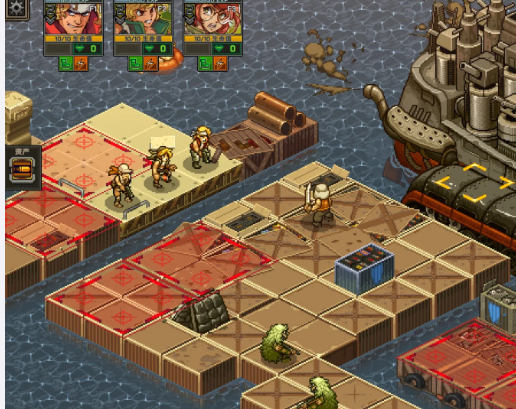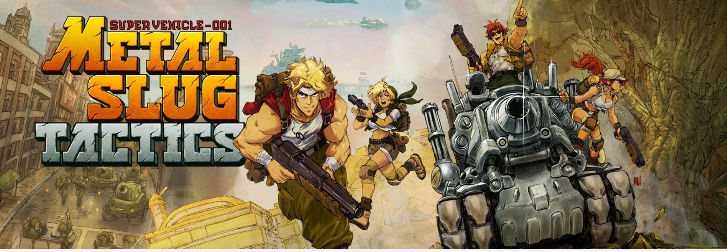On November 5, the long-awaited Metal Slug Tactics was finally officially released. As a new product in the Metal Slug universe, this game is the series’ first attempt at a tactical RPG. The developer Leikir Studio has previously launched works such as Grifters of Deception, which have received good reviews overall. Will it be able to live up to its mission by taking over the creation of the Metal Slug IP this time?
Those who are familiar with the original Metal Slug will definitely feel a sense of familiarity when they see the graphics of this game. Whether it is the vivid pixel characters or the hand-painted map environment that retains the charm of the original, they all have the magic of instantly pulling people back to the golden age of arcades.
However, the gameplay is quite different from the original series. As the name suggests, this game is a strategy game. If you look closely at the underlying gameplay design of Metal Slug Tactics, you can clearly see a lot of influence from Into the Breach. But after actually playing the game, you will find that the difference between the two is quite large.
In terms of plot, the game still chooses the theme of “destroying the modern rebels”, which is unshakable and simple. In addition to the six members of the Peregrine Squad, the available characters also include the “Angry Team” trio of “The King of Fighters”, which includes all the available characters in the original game. The nine members have their own characteristics and unique skills, but at the beginning, only Marco, Yingli and Fio can fight. The rest of the members, including the sunglasses Gotama, can only be unlocked after achieving specific clearance goals. Each character has two weapons, of which the main weapon is weaker and can be used an unlimited number of times. Special weapons are more powerful and have the ability to kill the enemy with one blow, but there is an ammunition limit, and after it is exhausted, it needs to be replenished through level rewards.
Unlike the expected “Advanced Wars” mode, “Metal Slug: Tactics” takes the “strategic rogue” route. In each round of the game, players can control three members and start a journey of attacking levels on four major maps. Three of them are the main exploration areas. After the team breaks into the randomly generated stronghold level, they must choose a strategy.
Each level is a miniature battlefield with different strategic objectives, including annihilating all enemy soldiers, killing specific targets, reaching the retreat area, protecting units, etc. There are 20 in total. After destroying the stronghold, we can get corresponding rewards, such as currency, ammunition, etc. If you can also achieve secondary goals well, you can get extra rewards.
After completing a certain number of levels, a boss will appear on the map. It is powerful and has corresponding mechanisms. They are all iconic enemies that have appeared in the series, such as the tracked warship Big Shiee and the large robot Jupiter King. After successfully defeating the boss, the area is declared conquered. The last city area is the station of General Morden, which can be regarded as the final boss. The process is almost linear, and you can challenge it as long as you conquer any block.

After completing a level, the character can increase his experience points, and each level upgrade will give him the opportunity to strengthen his firearms and learn skills. The skills in Metal Slug Tactics are divided into active and passive skills. The release of active skills requires adrenaline, while passive skills can take effect at any time. In principle, the more battles you fight, the greater the overall strength of the team. However, as the process deepens, the difficulty of the level also gradually increases. This gives players the choice of whether to go to Modern for a quick battle after finishing one area, or to clear all areas steadily and raise the team to a satisfactory level before considering clearing the level.
Cover is also an integral part of this type of game. Covers on the maps of Metal Slug Tactics are marked with blue indicators, most of which are half-body obstacles, and the moving grid is also specially represented by blue. Regardless of the enemy or friend, as long as you get close to the corresponding position, it will take effect, and the function is to provide two points of damage reduction. When a unit is damaged here, the corresponding value must be reduced before calculation.
What’s more interesting is that the cover does not distinguish between inside and outside, as long as you are close to it, it will be effective, even if the opponent is firing from the other side with no cover at all, completely ignoring the rules of physics.
In addition, most bunkers have health settings and can be destroyed by attacks. For difficult enemies hiding in bunker areas, players can consider using special skills to move them elsewhere, or simply destroy the bunker to remove the defense. However, the definition of bunker in the game is slightly limited, and walls that are not marked with blue marks are not counted. As a result, when I play the game, I often place units next to walls that look tall and thick but are not counted as bunkers due to visual misleading, resulting in a lot of unnecessary losses.
Of course, when it comes to the combat design of Metal Slug Tactics, the mobility bonus system cannot be ignored.
Perhaps in order to highlight the high mobility of the Peregrine Squad, the system of this game strongly encourages players to make large moves of units every round.
Specifically, as long as our character moves in the current round, they can gain “adrenaline” and “dodge points” according to the distance. Adrenaline was mentioned earlier and is used to release active skills. Dodge points can be generally regarded as additional defensive resources that can offset the damage caused by the enemy in the current round.
The importance of these two resources to the battle situation is self-evident. In addition to providing more sufficient output, special skills can also achieve recovery, displacement and other effects when combined with related passive skills. Dodge points are even more important. Since there is no health bonus when upgrading, the bodies of team members are quite fragile from beginning to end. If there is no temporary reinforcement provided by movement, I am afraid that they will soon fall under the siege of the enemy.
However, this design can hardly be called sophisticated – the battlefield map itself is very small, and there are only a few cover positions. Players can start to play steadily after finding a suitable point, or they can effectively reach the enemy with just a few position changes. Now they have to rack their brains to run to the farthest point every round, and then consider attacking after getting the movement benefit, which feels a bit like putting the cart before the horse.
Overall, even without the sentimental bonus, Metal Slug Tactics is still an excellent game with a lot of fun. The game is not easy, and the strategic elements are quite rich. There are many decision-making branches for players, plus weapons with different effects, special skills, and character talents, combined with the variability brought by the “rough” gameplay, it is indeed very attractive to strategy chess enthusiasts.
But then again, most of the players who still remember Metal Slug today are action shooting fans who are keen on the main works of the series. Using this brand to engage in hardcore strategy gameplay will undoubtedly greatly weaken the appeal of the IP.
At present, SNK seems to have gotten out of the trough and has shown signs of gradual recovery, and its series have gradually begun to revive. After experiencing operations such as linkage, mobile games, and genre changes, the appearance of “Metal Slug 8” in the future is probably what fans really want to see.
